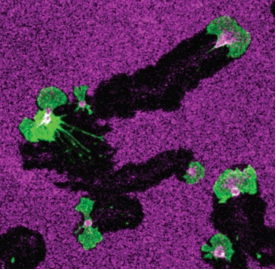Vascular surveillance by haptotactic blood platelets in inflammation and infection
Haptotaxis identified as a key effector function of immune - responsive platelets
13.11.2020
Breakdown of vascular barriers is a major complication of inflammatory diseases causing severe bleedings. An interdisciplinary research team led by Florian Gaertner showed that platelets scan for fibrin deposited on the inflamed vasculature and migrate along gradients of the adhesive ligand. Specific abrogation of lamellipodia, a type of actin-driven protrusion at the platelet front, interferes with haptotactic repositioning of platelets to microlesions, thus impairing vascular sealing and provoking inflammatory microbleeding. During infection, haptotaxis promotes capture of bacteria (see Figure) and prevents hematogenic dissemination, rendering platelets gate-keepers of the inflamed microvasculature. The authors published their findings in Nature Communications.
Collaborative effort
First author Leo Nicolai was a member of the graduate program IRTG SFB914 and the project greatly benefited from a close collaboration between colleagues of projects A02 (PI Daniela Maier-Begandt/Barbara Walzog), A10 (PI Christian Schulz), B02 (PI Konstantin Stark, Steffen Massberg), B03 (PI Christoph Reichel) and B10 (PI Ludwig Weckbach).
Publication
Nicolai, L., Schiefelbein, K., Lipsky, S. et al. Vascular surveillance by haptotactic blood platelets in inflammation and infection. Nat Commun 11, 5778 (2020). https://doi.org/10.1038/s41467-020-19515-0


